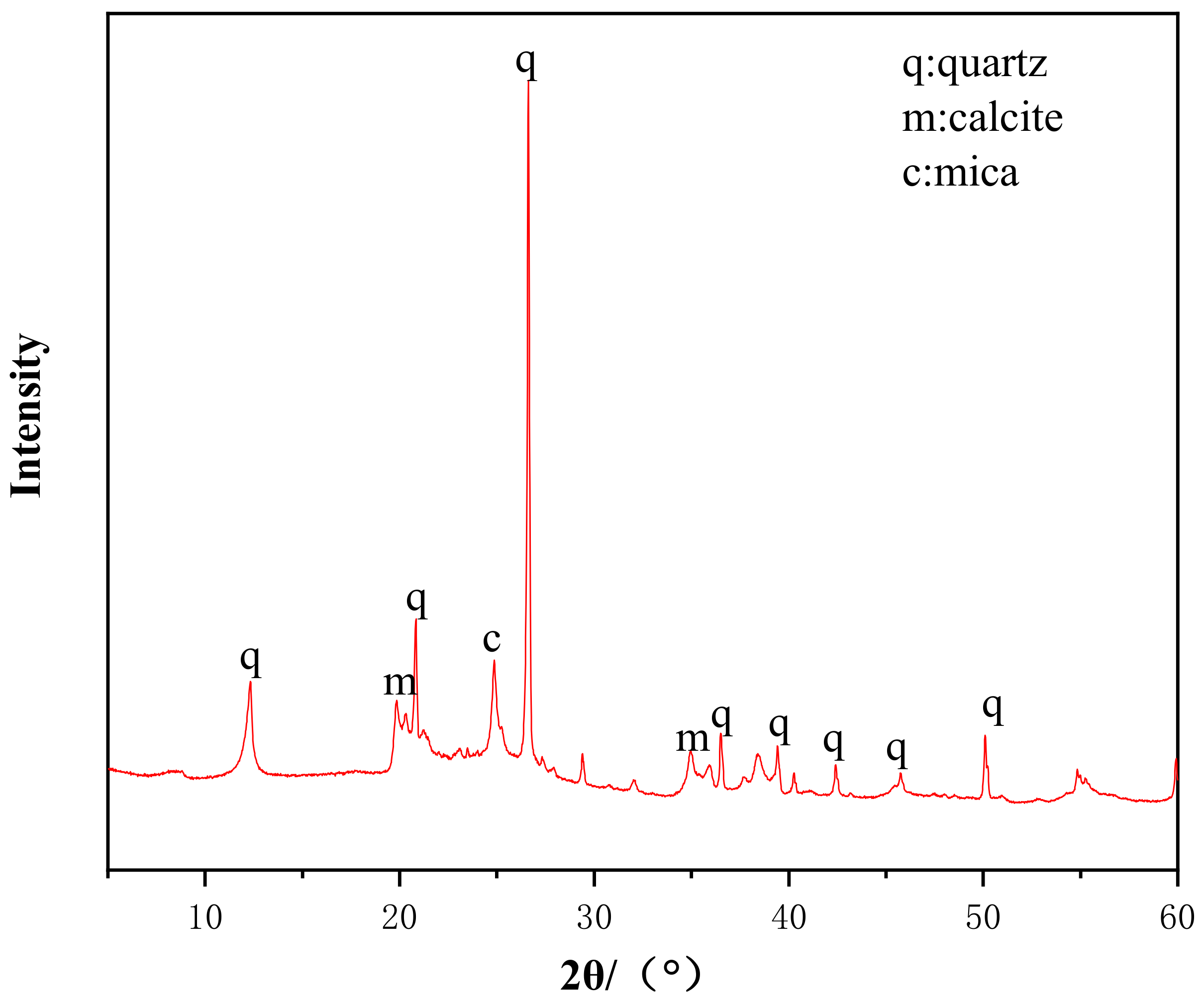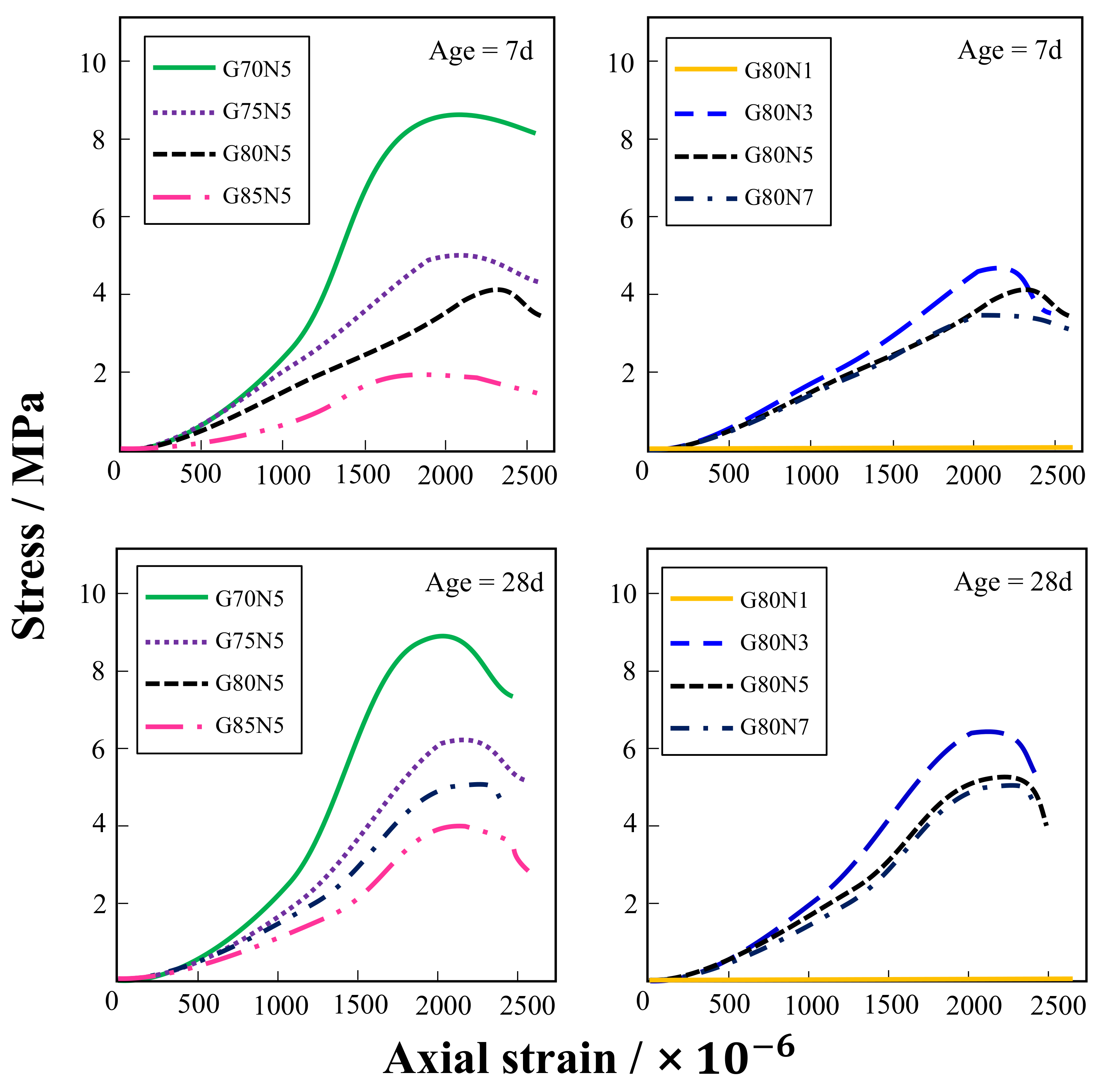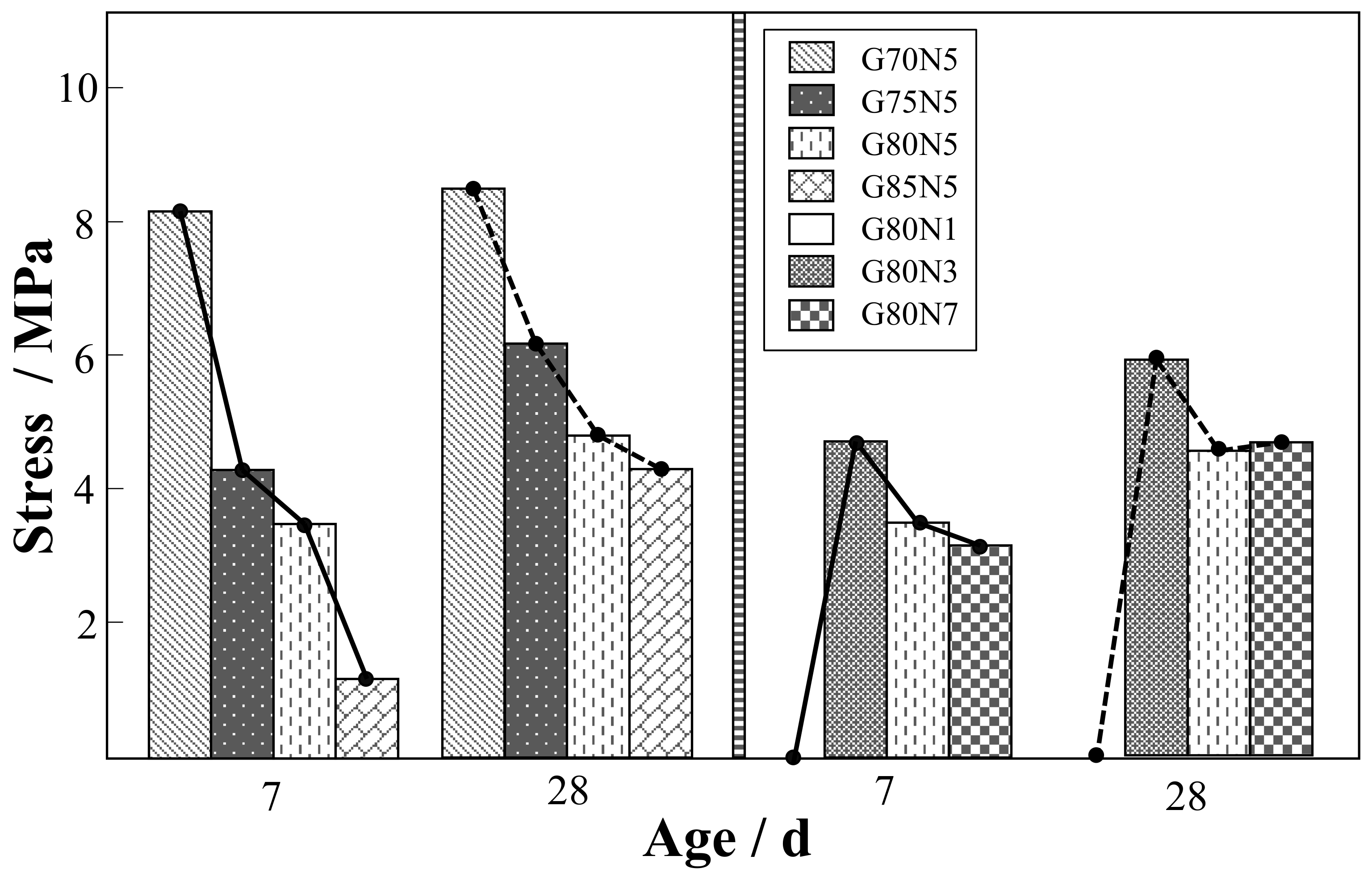Experimental Study of the Mechanical and Microstructure Characteristics of Coal Gangue Road Stabilization Materials Based on Alkali Slag Cementation
Abstract
:1. Introduction
2. Test
2.1. The Raw Material
2.2. Material Ratio
2.3. Test Methods
2.3.1. Microstructure
2.3.2. Porosity Test
3. Results and Discussion
3.1. Mechanical Properties of Whole-Solid-Waste Coal Gangue Road Stabilization Materials
3.2. Porosity Test
3.3. Microstructure Analysis
4. Conclusions
- As the alkali equivalent increases from 1% to 7%, the unconfined compressive strength of the alkali-activated gangue road stabilization materials at first increases and then decreases, and 3% is the optimal group (4.69 MPa on day 7 and 5.88 MPa on day 28);
- When the gangue aggregate rate increases from 70% to 85%, the NaOH of the unit gangue mixture decreases with the increase in the gangue aggregate rate, the hydration reaction rate slows down, and the cementite content decreases. Hence, the higher the porosity of the mixture, the lower the compressive strength of the mixture;
- It is feasible to use alkali-activated slag as a cementing material to prepare a whole-solid-waste coal gangue road stabilization material that can meet standard requirements. This material has the characteristics of fast hardening, early strength, and, compared with the ordinary crushed stone stabilized base, costs can be saved by 39.2%.
Author Contributions
Funding
Institutional Review Board Statement
Informed Consent Statement
Data Availability Statement
Conflicts of Interest
References
- Querol, X.; Izquierdo, M.; Monfort, E.; Alvarez, E.; Font, O.; Moreno, T.; Alastuey, A.; Zhuang, X.; Lu, W.; Wang, Y. Environmental characterization of burnt coal gangue banks at Yangquan, Shanxi Province, China. Int. J. Coal Geol. 2008, 75, 93–104. [Google Scholar] [CrossRef]
- Kefeni, K.K.; Msagati, T.; Mamba, B. Acid mine drainage: Prevention, treatment options, and resource recovery: A review. J. Clean. Prod. 2017, 151, 475–493. [Google Scholar] [CrossRef]
- Cheng, Y.; Hongqiang, M.; Hongyu, C.; Jiaxin, W.; Jing, S.; Zonghui, L.; Mingkai, Y. Preparation and characterization of coal gangue geopolymers. Constr. Build. Mater. 2018, 187, 318–326. [Google Scholar] [CrossRef]
- Frías, M.; La Villa, R.V.; Rojas, M.S.; Medina, C.; Valdés, A.J. Scientific Aspects of Kaolinite Based Coal Mining Wastes in Pozzolan/Ca(OH)2 System. J. Am. Ceram. Soc. 2011, 95, 386–391. [Google Scholar] [CrossRef]
- Yang, M.; Guo, Z.; Deng, Y.; Xing, X.; Qiu, K.; Long, J.; Li, J. Preparation of CaO–Al2O3–SiO2 glass ceramics from coal gangue. Int. J. Miner. Process. 2012, 102, 112–115. [Google Scholar] [CrossRef]
- Li, Z.; Luo, Z.; Li, X.; Liu, T.; Guan, L.; Wu, T.; Lu, A. Preparation and characterization of glass–ceramic foams with waste quartz sand and coal gangue in different proportions. J. Porous Mater. 2016, 23, 231–238. [Google Scholar] [CrossRef]
- Dong, Z.; Xia, J.; Fan, C.; Cao, J. Activity of calcined coal gangue fine aggregate and its effect on the mechanical behavior of cement mortar. Constr. Build. Mater. 2015, 100, 63–69. [Google Scholar] [CrossRef] [Green Version]
- Huang, G.; Ji, Y.; Li, J.; Hou, Z.; Dong, Z. Improving strength of calcinated coal gangue geopolymer mortars via increasing calcium content. Constr. Build. Mater. 2018, 166, 760–768. [Google Scholar] [CrossRef]
- Li, D.; Song, X.; Gong, C.; Pan, Z. Research on cementitious behavior and mechanism of pozzolanic cement with coal gangue. Cem. Concr. Res. 2006, 36, 1752–1759. [Google Scholar] [CrossRef]
- Gao, S.; Zhao, G.; Guo, L.; Zhou, L.; Yuan, K. Utilization of coal gangue as coarse aggregates in structural concrete. Constr. Build. Mater. 2021, 268, 121212. [Google Scholar] [CrossRef]
- Zhu, H.; Yang, S.; Li, W.; Li, Z.; Fan, J.; Shen, Z. Study of Mechanical Properties and Durability of Alkali-Activated Coal Gangue-Slag Concrete. Materials 2020, 13, 5576. [Google Scholar] [CrossRef]
- Chen, S.; Du, Z.; Zhang, Z.; Yin, D.; Feng, F.; Ma, J. Effects of red mud additions on gangue-cemented paste backfill properties. Powder Technol. 2020, 367, 833–840. [Google Scholar] [CrossRef]
- Fang, L.; Xinju, L.; Le, H.; Anran, S. A long-term study on the soil reconstruction process of reclaimed land by coal gangue filling. Catena 2020, 195, 104874. [Google Scholar] [CrossRef]
- Xuchao, S.J.; Ping, Z. An application of coal gangue in subgrade engineering. Subgrade Eng. 2008, 2, 153–154. [Google Scholar]
- Yu, Q.; Linchang, M.; Songyu, L. Research status and examples of coal gangue application in road construction Highway trans-portation science and technology. J. Highway Transp. Res. Dev. 2002, 19, 1–5. [Google Scholar]
- Shangjun, H. Application of Gangue as Base Course Material of Pavement for Highways. J. Railw. Eng. Soc. 1999, 1, 118–121. [Google Scholar]
- Liu, C.; Deng, X.; Liu, J.; Hui, D. Mechanical properties and microstructures of hypergolic and calcined coal gangue based geopolymer recycled concrete. Constr. Build. Mater. 2019, 221, 691–708. [Google Scholar] [CrossRef]
- De Brito, J.; Kurda, R. The past and future of sustainable concrete: A critical review and new strategies on cement-based materials. J. Clean. Prod. 2020, 281, 123558. [Google Scholar] [CrossRef]
- Palomo, A.; Grutzeck, M.; Blanco-Varela, M.T. Alkali-activated fly ashes: A cement for the future. Cem. Concr. Res. 1999, 29, 1323–1329. [Google Scholar] [CrossRef]
- Shahedan, N.; Abdullah, M.; Mahmed, N.; Kusbiantoro, A.; Tammas-Williams, S.; Li, L.-Y.; Aziz, I.; Vizureanu, P.; Wysłocki, J.; Błoch, K.; et al. Properties of a New Insulation Material Glass Bubble in Geo-Polymer Concrete. Materials 2021, 14, 809. [Google Scholar] [CrossRef]
- Frasson, B.J.; Pinto, R.C.; Rocha, J.C. Influence of different sources of coal gangue used as aluminosilicate powder on the mechanical properties and microstructure of alkali-activated cement. Mater. Constr. 2019, 69, 199. [Google Scholar] [CrossRef] [Green Version]
- Jin, L.; Huang, G.; Li, Y.; Zhang, X.; Ji, Y.; Xu, Z. Positive Influence of Liquid Sodium Silicate on the Setting Time, Polymerization, and Strength Development Mechanism of MSWI Bottom Ash Alkali-Activated Mortars. Materials 2021, 14, 1927. [Google Scholar] [CrossRef] [PubMed]
- Zulkifli, N.; Abdullah, M.; Przybył, A.; Pietrusiewicz, P.; Salleh, M.; Aziz, I.; Kwiatkowski, D.; Gacek, M.; Gucwa, M.; Chaiprapa, J. Influence of Sintering Temperature of Kaolin, Slag, and Fly Ash Geopolymers on the Microstructure, Phase Analysis, and Electrical Conductivity. Materials 2021, 14, 2213. [Google Scholar] [CrossRef] [PubMed]
- Abdullah, A.; Hussin, K.; Abdullah, M.; Yahya, Z.; Sochacki, W.; Razak, R.; Błoch, K.; Fansuri, H. The Effects of Various Concentrations of NaOH on the Inter-Particle Gelation of a Fly Ash Geopolymer Aggregate. Materials 2021, 14, 1111. [Google Scholar] [CrossRef]
- Lancellotti, I.; Piccolo, F.; Traven, K.; Češnovar, M.; Ducman, V.; Leonelli, C. Alkali Activation of Metallurgical Slags: Reactivity, Chemical Behavior, and Environmental Assessment. Materials 2021, 14, 639. [Google Scholar] [CrossRef]
- Zailani, W.W.A.; Abdullah, M.M.A.B.; Arshad, M.F.; Razak, R.A.; Tahir, M.F.M.; Zainol, R.R.M.A.; Nabialek, M.; Sandu, A.V.; Wysłocki, J.J.; Błoch, K. Characterisation at the Bonding Zone between Fly Ash Based Geopolymer Repair Materials (GRM) and Ordinary Portland Cement Concrete (OPCC). Materials 2020, 14, 56. [Google Scholar] [CrossRef]
- Tognonvi, M.T.; Rossignol, S.; Bonnet, J.-P. Effect of alkali cation on irreversible gel formation in basic medium. J. Non-Cryst. Solids 2011, 357, 43–49. [Google Scholar] [CrossRef]
- Zhao, X.; Wang, H.; Zhou, B.; Gao, H.; Lin, Y. Resistance of Soda Residue–Fly Ash Based Geopolymer Mortar to Acid and Sulfate Environments. Materials 2021, 14, 785. [Google Scholar] [CrossRef]
- Wang, Z.; Rehemituli, R.; Zhang, X. Study on the Compressive Strength of Alkali Activated Fly Ash and Slag under the Different Silicate Structure. Materials 2021, 14, 2227. [Google Scholar] [CrossRef]
- Brigolini Silva, G.J.; Santana, V.P.; Wojcik, M. Investigation on mechanical and microstructural properties of alkali-activated materials made of wood biomass ash and glass powder. Powder Technol. 2021, 377, 900–912. [Google Scholar] [CrossRef]
- Linhao, L.; Guangcheng, L.; Chaoneng, B.; Yuan, S.; Kulin, M.; Sheng, Z. Study on durability of coal gangue and its interface with cement stone under dry wet cycle. Coal Eng. 2019, 51, 153–159. [Google Scholar]
- Ma, H.; Zhu, H.; Wu, C.; Chen, H.; Sun, J.; Liu, J. Study on compressive strength and durability of alkali-activated coal gangue-slag concrete and its mechanism. Powder Technol. 2020, 368, 112–124. [Google Scholar] [CrossRef]
- Manhong, H.; Huang, M.; Zeng, J.; Cheng, Y.; Lei, T. Influence and Simulation of pH on leaching characteristics of highway gangue subgrade materials. Environ. Eng. 2014, 32, 773–776. [Google Scholar]
- JTG3430 Test Methods of Soils for Highway Engineering; Research Institute of Highway Ministry of Transport: China, Beijing, 2020.
- ASTM C20-00. Standard Test Methods for Apparent Porosity, Water Absorption, Apparent Specific Gravity, and Bulk Density of Burned Refractory Brick and Shapes by Boiling Water; American Society for Testing and Materials: West Conshohocken, PA, USA, 2015. [Google Scholar]




| Materials | Chemical Composition/% (XRF) | |||||||
|---|---|---|---|---|---|---|---|---|
| SiO2 | Al2O3 | Fe2O3 | CaO | MgO | K2O | Na2O | TiO2 | |
| Coal gangue | 56.26 | 27.48 | 10.73 | 1.56 | 0.48 | 0.21 | 0.77 | 1.51 |
| Materials | Chemical Composition/% (XRF) | ||||||
|---|---|---|---|---|---|---|---|
| CaO | SiO2 | Al2O3 | MgO | Fe2O3 | TiO2 | K2O | |
| Coal gangue | 43.70 | 26.50 | 18.20 | 4.90 | 1.00 | 1.00 | 0.80 |
| Mixture | Gangue | Slag | NaOH | Water |
|---|---|---|---|---|
| G70N5 | 70 | 20.000 | 1.290 | 10.000 |
| G75N5 | 75 | 16.667 | 1.075 | 8.333 |
| G80N5 | 80 | 13.333 | 0.860 | 6.667 |
| G85N5 | 85 | 10.000 | 0.645 | 5.000 |
| G80N1 | 80 | 13.333 | 0.172 | 6.667 |
| G80N3 | 80 | 13.333 | 0.516 | 6.667 |
| G80N7 | 80 | 13.333 | 1.204 | 6.667 |
| Mixture | Porosity/% | True Density (g/cm3) | Apparent Density (g/cm3) |
|---|---|---|---|
| G70N5 | 6.28 | 1.70 | 1.59 |
| G75N5 | 7.84 | 2.23 | 2.09 |
| G80N5 | 8.10 | 2.77 | 2.54 |
| G85N5 | 9.16 | 2.35 | 2.13 |
| G80N3 | 6.34 | 2.46 | 2.24 |
| G80N7 | 8.88 | 2.41 | 2.22 |
Publisher’s Note: MDPI stays neutral with regard to jurisdictional claims in published maps and institutional affiliations. |
© 2021 by the authors. Licensee MDPI, Basel, Switzerland. This article is an open access article distributed under the terms and conditions of the Creative Commons Attribution (CC BY) license (https://creativecommons.org/licenses/by/4.0/).
Share and Cite
Wang, C.; Yang, J.; Xu, S. Experimental Study of the Mechanical and Microstructure Characteristics of Coal Gangue Road Stabilization Materials Based on Alkali Slag Cementation. Materials 2021, 14, 3601. https://doi.org/10.3390/ma14133601
Wang C, Yang J, Xu S. Experimental Study of the Mechanical and Microstructure Characteristics of Coal Gangue Road Stabilization Materials Based on Alkali Slag Cementation. Materials. 2021; 14(13):3601. https://doi.org/10.3390/ma14133601
Chicago/Turabian StyleWang, Changbai, Junxin Yang, and Shuzhan Xu. 2021. "Experimental Study of the Mechanical and Microstructure Characteristics of Coal Gangue Road Stabilization Materials Based on Alkali Slag Cementation" Materials 14, no. 13: 3601. https://doi.org/10.3390/ma14133601






